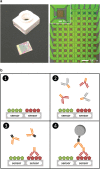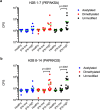Multiplex giant magnetoresistive biosensor microarrays identify interferon-associated autoantibodies in systemic lupus erythematosus
- PMID: 27279139
- PMCID: PMC4899742
- DOI: 10.1038/srep27623
Multiplex giant magnetoresistive biosensor microarrays identify interferon-associated autoantibodies in systemic lupus erythematosus
Abstract
High titer, class-switched autoantibodies are a hallmark of systemic lupus erythematosus (SLE). Dysregulation of the interferon (IFN) pathway is observed in individuals with active SLE, although the association of specific autoantibodies with chemokine score, a combined measurement of three IFN-regulated chemokines, is not known. To identify autoantibodies associated with chemokine score, we developed giant magnetoresistive (GMR) biosensor microarrays, which allow the parallel measurement of multiple serum antibodies to autoantigens and peptides. We used the microarrays to analyze serum samples from SLE patients and found individuals with high chemokine scores had significantly greater reactivity to 13 autoantigens than individuals with low chemokine scores. Our findings demonstrate that multiple autoantibodies, including antibodies to U1-70K and modified histone H2B tails, are associated with IFN dysregulation in SLE. Further, they show the microarrays are capable of identifying autoantibodies associated with relevant clinical manifestations of SLE, with potential for use as biomarkers in clinical practice.
Conflict of interest statement
D.A.H. and S.X.W. have related patents or patent applications assigned to Stanford University and out-licensed for potential commercialization. D.A.H. and S.X.W. have stock or stock options in MagArray, Inc., which has licensed relevant patents from Stanford University for commercialization of GMR biosensor chips. E.C.B. is a co-inventor on a patent related to use of chemokine levels to predict lupus flare, and received royalties from a licensing agreement related to that technology.
Figures





References
Publication types
MeSH terms
Substances
Grants and funding
LinkOut - more resources
Full Text Sources
Other Literature Sources
Medical
Research Materials
Miscellaneous

